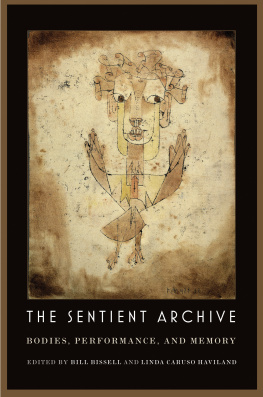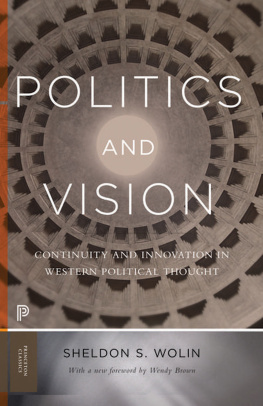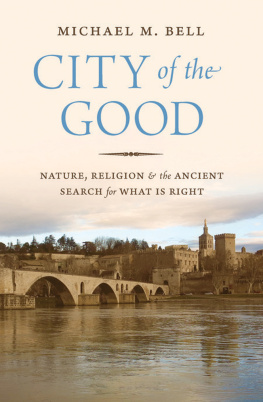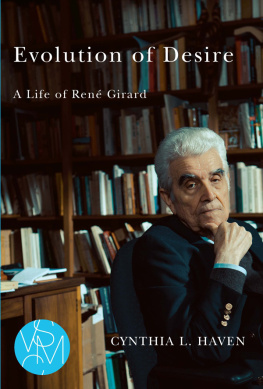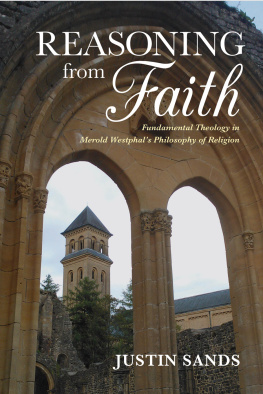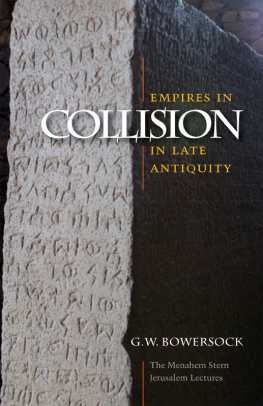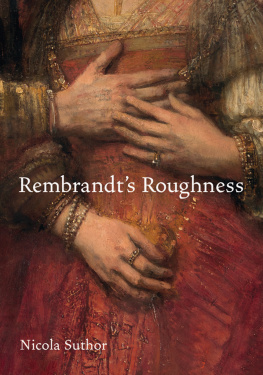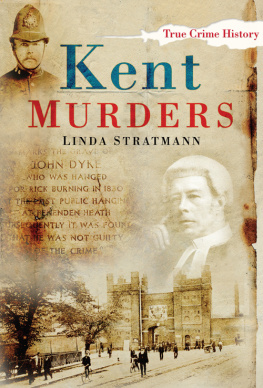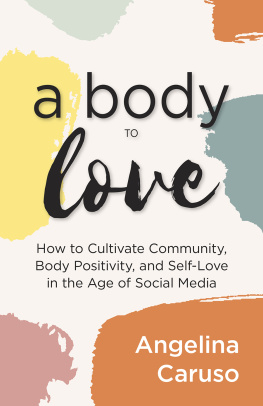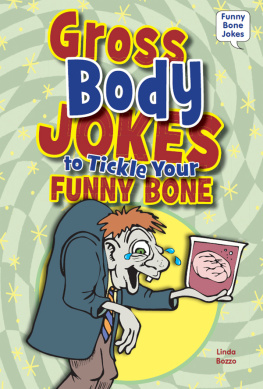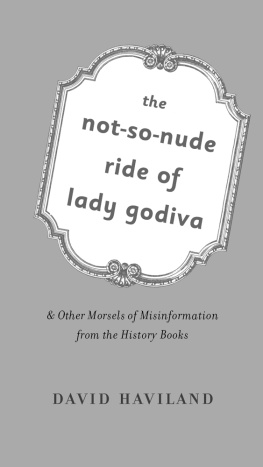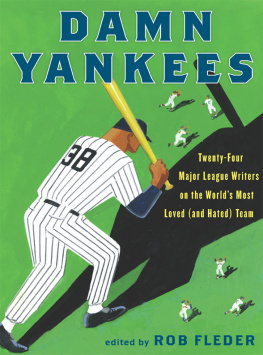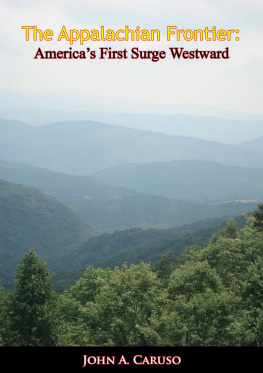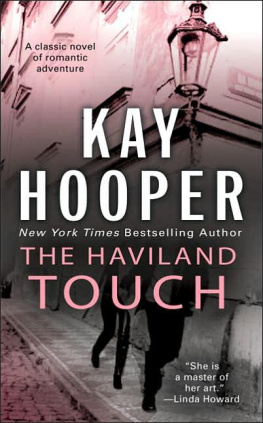
THE SENTIENT ARCHIVE

The Sentient Archive
BODIES, PERFORMANCE, AND MEMORY
Edited by BILL BISSELL and LINDA CARUSO HAVILAND
WESLEYAN UNIVERSITY PRESS Middletown, Connecticut
Wesleyan University Press
Middletown CT 06459
www.wesleyan.edu/wespress
2018 The Pew Center for Arts & Heritage
All rights reserved
Manufactured in the United States of America
Typeset in Quadraat by Tseng Information Systems, Inc.
Library of Congress Cataloging-in-Publication Data
Names: Bissell, Bill, editor. | Haviland, Linda Caruso, editor.
Title: The sentient archive: bodies, performance, and memory / edited by Bill Bissell and Linda Caruso Haviland.
Description: Middletown, Connecticut: Wesleyan University Press, [2018] | Includes bibliographical references and index. | Identifiers: LCCN 2017026923 (print) | LCCN 2017050853 (ebook) | ISBN 9780819577764 (ebook) | ISBN 9780819577740 (cloth : alk. paper) | ISBN 9780819577757 (pbk. : alk. paper)
Subjects: LCSH: DancePhilosophy. | Human body (Philosophy)
Classification: LCC GV1588 (ebook) | LCC GV1588 .S46 2018 (print) |
DDC 792.8dc23
LC record available at https://lccn.loc.gov/2017026923
5 4 3 2 1
Front cover illustration: Paul Klee (18791940), Angelus Novus, 1920 (Indian ink, color chalk and brown wash on paper) / The Israel Museum, Jerusalem, Israel / Carole and Ronald Lauder, New York / Bridgeman Images.
CONTENTS
Paula Marincola
Bill Bissell and Linda Caruso Haviland
Linda Caruso Haviland
Introduction by Linda Caruso Haviland /
Alain Platel
Tomie Hahn
Juhani Pallasmaa
Meg Stuart
Bonnie Bainbridge Cohen
Ralph Lemon
Ralph Lemon
Introduction by Linda Caruso Haviland /
Barbara Dilley
Ivo van Hove
Ann Cooper Albright
Allegra Kent
Catherine J. Stevens
Emily Johnson
Introduction by Linda Caruso Haviland /
David Gordon
Laurajane Smith
Sarah Crowner
Nancy Goldner
Patricia Hoffbauer
Introduction by Linda Caruso Haviland /
Bebe Miller
Deborah Hay
Jayachandran Palazhy
Jenn Joy
Gregory Maqoma
Introduction by Linda Caruso Haviland /
Marcia B. Siegel
Jennifer Monson
Thomas F. DeFrantz
Mariana Ibaez and Simon Kim
Andr Lepecki
.
FOREWORD
The Pew Center for Arts & Heritage is a multidisciplinary grant maker, funded by The Pew Charitable Trusts, dedicated to fostering a vibrant cultural community in greater Philadelphia. As a funder, the Center invests annually in ambitious, imaginative projects in the Performance and Exhibitions & Public Interpretation programs, in individual artists fellowships, and in catalytic organizational development. Our efforts foster and showcase the great cultural richness and vitality of our region, enhancing public life and reaching many different audiences.
The Center also actively engages in an ongoing exchange of ideas concerning artistic and interpretive practice and functions as a hub for discourse and knowledge sharing about crucial issues in current creative practice. In that capacity, we create opportunities for inquiry, debate, and analysis, from lectures and workshops to newly commissioned writings. Beginning in 2006, with an anthology of texts on curatorial practice, What Makes a Great Exhibition?, followed by Letting Go? Sharing Historical Authority in a User-Generated World (2011) and Pigeons on the Grass Alas: Contemporary Curators Talk About the Field (2013), we have regularly produced print publications on topics that grow directly out of and respond to our experience as cultural grant makers.
In addition, our danceworkbook series of publications, in the form of DVDS and Web-based productions, has established a body of reference materials for choreographic creation and development. They provide a view into the process and backstory of making dance or, as in the case of A Steady Pulse: Restaging Lucinda Childs, 19631978 (2015), present a rich and interactive archive documenting an important stage in an artists trajectory. All our publishing efforts aim to generate insights and further discussion for artists, curators, presenters, producers, critics, and scholars alike and to make a contribution to the fields we serve that amplifies the impact of our grant dollars.
The Sentient Archive grew in part out of the audience response to lectures by Dr. Susan Leigh Foster, hybrids of performance and theory that were produced in 2011 by the Center with the cooperation of the Philadelphia Live Arts Festival. These were subsequently collected in the danceworkbook publication Susan Foster! Susan Foster! Three Performed Lectures (2013). Question-and-answer sessions following Fosters presentations revealed certain divisions among practitioners, theorists, and critics, most notably in some practitioners rejection of theorys intrusion into the privileged territory of the body. The coeditors of this anthology, Bill Bissell, director of Performance here at the Center, and Linda Caruso Haviland, founding director of the dance program at Bryn Mawr College, envisioned an approach to bridging the gap by commissioning a diverse set of writings by artists, theorists, and scholars. As this idea evolved, practitioners and researchers in other disciplines were invited to be part of the collection. As a way to foreground the analytical and the experiential in equal measure, the coeditors began by positing the sentient, living body as an archive of knowledge and experience, the nucleus of every approach to performance. Dance is at the core of this investigation, but the anthology aims to reach beyond dance, even performance, by drawing on contributors who work with the body in other fields. The result is a shared space for multiple voices to spark insight and fruitful discussion across disciplinary and professional boundaries.
What you hold in your hands, then, is a rich compendium of textsfrom analytical to anecdotal, from memoir to researchthat we hope will find a welcome reception among its many potential audiences. Bill and Linda, as coeditors, have demonstrated both vision and extraordinary commitment in bringing this publication to fruition, and I want to acknowledge and applaud their tremendous work here, along with the writers and other contributors to The Sentient Archive.
Most important, none of the Centers work would be possible without the extraordinarily generous support and rigorous strategic leadership of our funder, The Pew Charitable Trusts. Their belief in the value and impact of the Centers activities forwards and sustains our endeavors. It is indeed our privilege to work on Pews behalf in the cultural arena.
Paula Marincola
Executive Director
The Pew Center for Arts & Heritage
ACKNOWLEDGMENTS
The Sentient Archive: Bodies, Performance, and Memory could not have been realized without the significant support of numerous people. First and foremost, we must thank The Pew Center for Arts & Heritage, Philadelphia, through which this book came to fruition. It was a happy coincidence that early conversations about the anthology with coeditor Linda Caruso Haviland occurred just as Paula Marincola, the Centers executive director, and Doug Bohr, former director of the Philadelphia Program, The Pew Charitable Trusts, offered me the opportunity to develop a publication project as part of my work as director of the Centers Performance program. Paula, in particular, has always believed in
Next page
